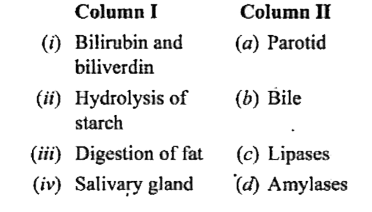Match the columns : (a) Atrial systole (Column I) (i) 0.7 seconds (Column II) , (b) Joint diastole (Column I) (ii) 0.3 seconds (Columnn II) (c) Ventricular systole (Column I) (iii) 0.1 second (Column II) , (d) Atrial diastole (Column I) (iv) 0.4 seconds (Column II)
a(iii) , b(iv), c(ii), d(i)
a(iv), b(iii), c(ii), d(i)
a(iii), b(iv), c(i), d(ii)
a(i), b(ii), c (iii), d(iv)
The correct Answer is:A
To solve the question of matching the columns regarding the phases of the cardiac cycle with their respective durations, we will follow these steps:
Step 1: Identify the duration of each phase
1. Atrial Systole: This is the contraction of the atria and lasts for 0.1 seconds.
2. Joint Diastole: This phase occurs when both the atria and ventricles are in diastole (relaxation) and lasts for 0.4 seconds.
3. Ventricular Systole: This is the contraction of the ventricles and lasts for 0.3 seconds.
4. Atrial Diastole: This phase is when the atria are relaxed and lasts for 0.7 seconds.
Step 2: Match each phase with its duration
- (a) Atrial Systole → (iii) 0.1 seconds
- (b) Joint Diastole → (iv) 0.4 seconds
- (c) Ventricular Systole → (ii) 0.3 seconds
- (d) Atrial Diastole → (i) 0.7 seconds
Step 3: Write the final matches
1. Atrial Systole → 0.1 seconds (iii)
2. Joint Diastole → 0.4 seconds (iv)
3. Ventricular Systole → 0.3 seconds (ii)
4. Atrial Diastole → 0.7 seconds (i)
Final Matching:
- (a) Atrial Systole → (iii) 0.1 seconds
- (b) Joint Diastole → (iv) 0.4 seconds
- (c) Ventricular Systole → (ii) 0.3 seconds
- (d) Atrial Diastole → (i) 0.7 seconds
1. Atrial Systole: This is the contraction of the atria and lasts for 0.1 seconds.
2. Joint Diastole: This phase occurs when both the atria and ventricles are in diastole (relaxation) and lasts for 0.4 seconds.
3. Ventricular Systole: This is the contraction of the ventricles and lasts for 0.3 seconds.
4. Atrial Diastole: This phase is when the atria are relaxed and lasts for 0.7 seconds.
- (a) Atrial Systole → (iii) 0.1 seconds
- (b) Joint Diastole → (iv) 0.4 seconds
- (c) Ventricular Systole → (ii) 0.3 seconds
- (d) Atrial Diastole → (i) 0.7 seconds
1. Atrial Systole → 0.1 seconds (iii)
2. Joint Diastole → 0.4 seconds (iv)
3. Ventricular Systole → 0.3 seconds (ii)
4. Atrial Diastole → 0.7 seconds (i)
- (a) Atrial Systole → (iii) 0.1 seconds
- (b) Joint Diastole → (iv) 0.4 seconds
- (c) Ventricular Systole → (ii) 0.3 seconds
- (d) Atrial Diastole → (i) 0.7 seconds
Topper's Solved these Questions
Similar Questions
Match the columns and choose the correct answer.
(a) Aldosterone (Column I) (i) Zona fasciculata (Column II) (b) DHEA (Column I) (ii) Zona glomerulosa (Column II) (c) Cortisol (Column I) (iii) Zona reticulans (Column II) (d) Adrenaline (Column I) (iv) Adrenal medulla (Column II)
View SolutionMatch the column I and column II.

View Solution
Knowledge Check
Match the Column I and Column II:
 A1. i. 2. ii 3. iii 4. ivB1. i 2. ii 3. iii 4. ivC1. i2. ii 3. iii 4. ivD1. i 2. ii 3. iii 4. iv
A1. i. 2. ii 3. iii 4. ivB1. i 2. ii 3. iii 4. ivC1. i2. ii 3. iii 4. ivD1. i 2. ii 3. iii 4. ivMatch the Column I and Column II:
 A1. i 2. ii 3. iii 4. ivB1. i 2. ii 3. iii 4. ivC1. i 2. ii 3. iii 4. ivD1. i 2. ii 3. iii 4. iv
A1. i 2. ii 3. iii 4. ivB1. i 2. ii 3. iii 4. ivC1. i 2. ii 3. iii 4. ivD1. i 2. ii 3. iii 4. iv
Match column I and column II w.r.t. cranial capacity (a)Homo erectus (Column I) (i) 650-800 cc (Column II) (b) Homosapians (Column I) (ii)1650 cc (Column II) (c) Cro-magnon (Column I) (iii) 1400 cc (Column II) (d) Homo habilas (Column I) (iv) 900 cc (Column II) .Choose the correct option
View SolutionMatch the column I and with Column II

View SolutionMatch the column I with column II

View SolutionMatch the column I with column II

View SolutionMatch the column I with column II

View SolutionMatch the column I with Column II

View Solution
